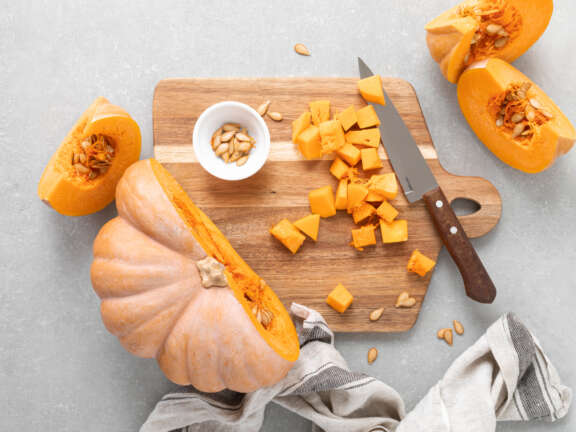6 Health Benefits of Pumpkin: Nature's Superfood


At this time of year, you’re probably noticing a lot of pumpkin and pumpkin spice foods popping up—in everything from flavored coffees to cookies, and even breakfast cereals.
Some of these foods are anything but healthy. A popular Pumpkin Cream Cold Brew, for example, contains 250 calories and 31 grams of sugar.
However, pumpkin itself is very nutritious. It’s very low in calories, containing about 50 calories per cup when cooked. Plus, it’s packed with vitamins, minerals, and antioxidants.
Here are several of the many health benefits of pumpkin.
1. Protects Your Eyes & Improves Vision
Pumpkin gives you beta carotene, which your body turns into vitamin A, an important antioxidant. Vitamin A helps to keep your vision healthy. Plus, it helps us to form a pigment in your eyes that helps you to see in the dark, such as when you’re driving.
Beta carotene also helps to keeps the surface of your eyes healthy, which is important for your vision. So, if you want to keep your eyes sharp as you age, add some pumpkin to your plate!
2. Boosts Your Immune System
If you’re feeling a cold coming on, you might want to add more pumpkin to your diet. That’s because it contains vitamin C, which supports the white blood vessels that are the first line of defense of your immune system. White blood cells spot and rid your body of germs, helping to fight off infections.
The beta carotene in pumpkin, which your body converts to vitamin A, also helps to protect your immune system from damage. Plus, pumpkin contains zinc that helps to support your immune system cells.
3. Keeps Your Digestive System Healthy
Struggling with constipation? You may want to add more pumpkin to your diet. That’s because it’s high in fiber, which supports healthy digestion and regularity. You can think of fiber as a “broom” for your intestines, helping to sweep away waste and prevent constipation.
The fiber in pumpkin also acts as a prebiotic which “feeds” the good bacteria in your gut, improving your digestion. Plus, the combination of fiber and water in pumpkin can help you feel full longer, which is not only good for your digestion may help you eat less and lose weight.
4. Supports a Healthy Heart
Pumpkin supports your heart in several important ways. It supplies potassium, a mineral that helps to balance the sodium levels in your body, which relaxes your blood vessel walls and keeps your blood pressure healthy.
The fiber in pumpkin is also good for your cholesterol. That’s because it supplies soluble fiber, which attaches itself to cholesterol in your digestive system, helping to remove it from your body—preventing plaque buildup in your arteries and reducing your risk of heart disease.
5. Keeps Your Blood Sugar Healthy
If you’re concerned about your blood sugar, pumpkin can be a smart choice. That’s because it’s low on the glycemic index, meaning it won’t spike your blood sugar. Plus, the fiber in pumpkin helps to slow your digestion, which keeps your blood sugar levels steady.
6. Promotes Healthy, Glowing Skin
Pumpkin is good for your skin! The antioxidants in pumpkin, including beta-carotene and vitamins C and E, work together to fight free radicals that can damage your skin cells and speed up aging. Plus, they support the production of collagen, which is a protein in your skin that helps to keep it healthy and reduces wrinkles.
How to Eat Pumpkin
There are many delicious ways to enjoy pumpkin, whether you start with the fruit itself (yes, it is a fruit, not a vegetable!) or a can of pumpkin puree.
- Roasted Pumpkin: Roasting pumpkin brings out the rich, sweet, and slightly nutty flavor of pumpkin. Just cut it into cubes and toss it with olive oil, salt, and your favorite spices—such as cinnamon, nutmeg, and smoked paprika. Then, roast in the oven at 400°F until tender and caramelized.
- Pumpkin Soup: Peel, seed, and cube a medium sized pumpkin. Sauté chopped onions and minced garlic in olive oil, then add cubed pumpkin and cook briefly. Pour in vegetable or chicken broth and simmer until the pumpkin is tender. Then blend the mixture until smooth and stir in coconut milk or heavy cream. Season it to taste and enjoy!
- Pumpkin Salad: Toss roasted pumpkin with greens, nuts, and a vinaigrette for a delicious, hearty salad. You can even top it with toasted pumpkin seeds (pepitas).
- Pumpkin Risotto: Just stir roasted pumpkin into creamy risotto for a delicious, nutty, comforting fall dish.
- Pumpkin Dip: Blend pureed pumpkin with cream cheese, yogurt, and spices for a tasty dip with whole grain crackers or vegetables.
Is Pumpkin Pie Healthy?
Compared to other foods, pumpkin pie is a relatively healthy dessert. It tends to be lower in sugar than other pies and you can reduce the amount of sugar or use natural sweeteners to make it healthier.
Plus, using a whole grain or nut-based crust can increase the fiber in your pumpkin pie and make it healthier and more nutritious. Yet, like with any dessert, moderation is key.
Adding Pumpkin to Your Diet
You can find fresh pumpkins in your grocery store or farmer’s market, especially during the fall months. Plus, you buy it year-round as a canned puree.
Whether you enjoy it in a savory dish or as a sweet treat, pumpkin can enhance your meals while nourishing your body. So, this season (and beyond), don’t just carve it—eat it! It’s a tasty, enjoyable way to stay healthy.
